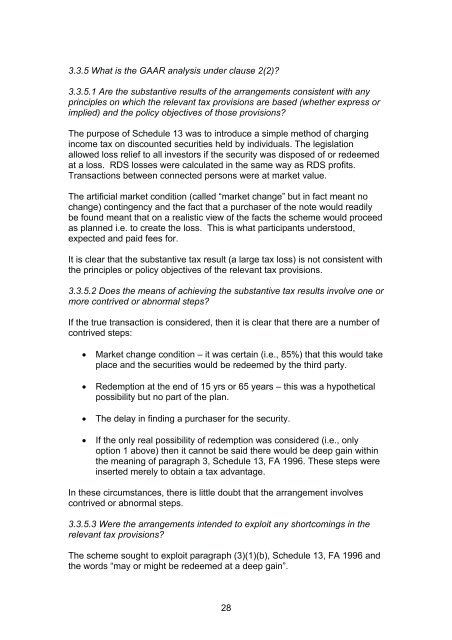Examples of how the GAAR applies to tax arrangements
Examples of how the GAAR applies to tax arrangements
Examples of how the GAAR applies to tax arrangements
Create successful ePaper yourself
Turn your PDF publications into a flip-book with our unique Google optimized e-Paper software.
3.3.5 What is <strong>the</strong> <strong>GAAR</strong> analysis under clause 2(2)?<br />
3.3.5.1 Are <strong>the</strong> substantive results <strong>of</strong> <strong>the</strong> <strong>arrangements</strong> consistent with any<br />
principles on which <strong>the</strong> relevant <strong>tax</strong> provisions are based (whe<strong>the</strong>r express or<br />
implied) and <strong>the</strong> policy objectives <strong>of</strong> those provisions?<br />
The purpose <strong>of</strong> Schedule 13 was <strong>to</strong> introduce a simple method <strong>of</strong> charging<br />
income <strong>tax</strong> on discounted securities held by individuals. The legislation<br />
allowed loss relief <strong>to</strong> all inves<strong>to</strong>rs if <strong>the</strong> security was disposed <strong>of</strong> or redeemed<br />
at a loss. RDS losses were calculated in <strong>the</strong> same way as RDS pr<strong>of</strong>its.<br />
Transactions between connected persons were at market value.<br />
The artificial market condition (called “market change” but in fact meant no<br />
change) contingency and <strong>the</strong> fact that a purchaser <strong>of</strong> <strong>the</strong> note would readily<br />
be found meant that on a realistic view <strong>of</strong> <strong>the</strong> facts <strong>the</strong> scheme would proceed<br />
as planned i.e. <strong>to</strong> create <strong>the</strong> loss. This is what participants unders<strong>to</strong>od,<br />
expected and paid fees for.<br />
It is clear that <strong>the</strong> substantive <strong>tax</strong> result (a large <strong>tax</strong> loss) is not consistent with<br />
<strong>the</strong> principles or policy objectives <strong>of</strong> <strong>the</strong> relevant <strong>tax</strong> provisions.<br />
3.3.5.2 Does <strong>the</strong> means <strong>of</strong> achieving <strong>the</strong> substantive <strong>tax</strong> results involve one or<br />
more contrived or abnormal steps?<br />
If <strong>the</strong> true transaction is considered, <strong>the</strong>n it is clear that <strong>the</strong>re are a number <strong>of</strong><br />
contrived steps:<br />
• Market change condition – it was certain (i.e., 85%) that this would take<br />
place and <strong>the</strong> securities would be redeemed by <strong>the</strong> third party.<br />
• Redemption at <strong>the</strong> end <strong>of</strong> 15 yrs or 65 years – this was a hypo<strong>the</strong>tical<br />
possibility but no part <strong>of</strong> <strong>the</strong> plan.<br />
• The delay in finding a purchaser for <strong>the</strong> security.<br />
• If <strong>the</strong> only real possibility <strong>of</strong> redemption was considered (i.e., only<br />
option 1 above) <strong>the</strong>n it cannot be said <strong>the</strong>re would be deep gain within<br />
<strong>the</strong> meaning <strong>of</strong> paragraph 3, Schedule 13, FA 1996. These steps were<br />
inserted merely <strong>to</strong> obtain a <strong>tax</strong> advantage.<br />
In <strong>the</strong>se circumstances, <strong>the</strong>re is little doubt that <strong>the</strong> arrangement involves<br />
contrived or abnormal steps.<br />
3.3.5.3 Were <strong>the</strong> <strong>arrangements</strong> intended <strong>to</strong> exploit any shortcomings in <strong>the</strong><br />
relevant <strong>tax</strong> provisions?<br />
The scheme sought <strong>to</strong> exploit paragraph (3)(1)(b), Schedule 13, FA 1996 and<br />
<strong>the</strong> words “may or might be redeemed at a deep gain”.<br />
28

















